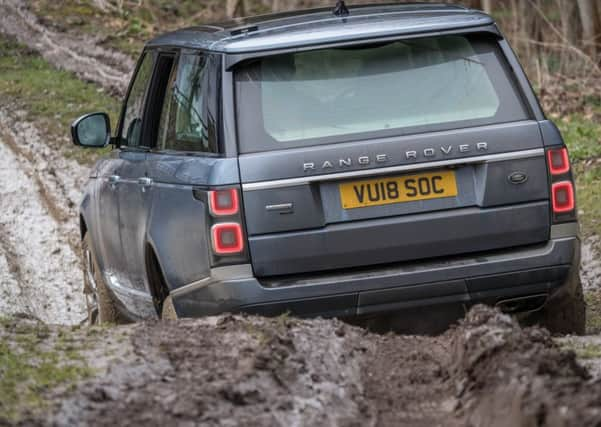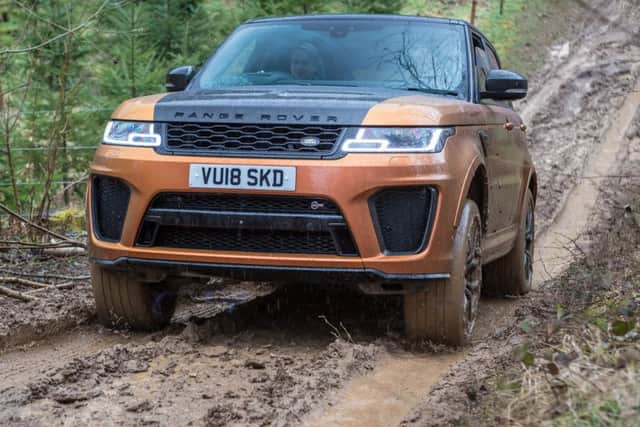Review: Range Rover P400e and Sport SVR


A PHEV has a conventional petrol engine and a battery which can be charged from a household plug. This means you can set out with maximum battery power. On the journey the battery is also recharged by the vehicle engine and by braking. You can reserve your pure battery power for toxic-free travel in town. The P400e in theory will travel around 30 miles solely on electric power – when the battery is fully boosted and you don’t ask it to do too much hard work. Lights, wipers, heating, inclines and acceleration deplete the battery so your pure electric range may fall short of 30 miles.
In the P400e it can also take you off-roading, though in reality you are more likely to rely on mixed petrol and battery power. It has the same deep-water wading ability of other Range Rovers but it is advisable to use petrol power so that water does not enter the exhaust system and give you financial angst.
Advertisement
Hide AdAdvertisement
Hide AdIn practice, unless your journeys are short, you’ll be running on a mix of petrol and electric power – the two engaging and co-operating automatically and seamlessly through the automatic gearbox.


A dedicated charging unit can fill the battery in less than three hours. A normal domestic plug takes nearer eight hours. This is the cheapest way to run any Range Rover – though frugality is not likely to bother someone who has already paid out at least £86,965 for the standard P400e and as much as £168,015 for the ultimate long wheelbase version in SV Autobiography specification.
With around 400 horsepower from the electric motor and the 2-litre petrol turbo engine, the P400e gives quiet and intense acceleration. The 0-60mph time is 6.4 seconds. Like any PHEV it has some remarkable official economy figures, namely 101mpg and just 64g of carbon dioxide. This brings tax benefits and a whopping green image. However, like other PHEVs, the reality is that in everyday driving you get nothing like the headline figures. On a road route in Worcestershire selected by Land Rover, our car’s trip computer suggested 23.7mpg. Land Rover’s engineer was unable to tell me what the CO2 figure would have been but it would be well into triple figures. A diesel-engined Range Rover would have given more mpg but not the pace or refinement. We were also sent into the wild woods, a muddy trial by ruts but these days the Range Rover’s ability makes these sort of tests almost an anticlimax. More and more, the guesswork is being eliminated by using the variety of traction aids. The “head-up” display in the windscreen now shows the steering angle of the front wheels.
The company is so confident that special tyres were not used: the point is also made that “any” Range Rover should be able to get through the mire without the need for special tyres. Or indeed, with almost any driver. On our event, complete novices got through – with the guidance of marshals at strategic points.
The P400e benefits from the thorough 2018 updates for the Range Rover, with improvements to seating comfort, and the latest twin-screen information and control system first seen in the Velar (which has just won the design title at the 2018 World Car Awards). There have been subtle tweaks to the styling inside and outside. Front and rear passengers get more USB, 12 volt and internet connection points, with up to eight 4G wi-fi links. A pixel laser headlamp option gives 500 metre night vision.
If you like the idea of the P400e it is available in the Range Rover Sport body from £70,800. Or… you could just forget all about green pretensions and CO2 posing and order the Sport SVR with a 567bhp 5-litre supercharged V8 engine – the most powerful and the fastest Range Rover. It has a top speed of 176mph and a 0-62mph time of 4.5 seconds (0-60 4.3 secs). Combined economy is 22.1mpg and the CO2 rating is a climate busting 294g. It costs £99,680. As part of the driving event, we went to Fen End, once the Prodrive test circuit, now home to Jaguar Land Rover’s special ops team where the metal is put to the test. It includes a mile straight, where we saw 151mph on the dial before trying the brakes.
Chassis settings have been altered to control body movement, both pitch and lean and turning forces. The front Supersport seats save 30kg in weight, and have additional side support. Front and rear seats are in perforated leather with SVR logos and are heated. The bonnet is carbon fibre and available in various paints. The famous Land Rover oval badge has been replaced by an SVO badge. There’s enough to catch the eye and ear of enthusiasts.
It is a formidable thing. Our mpg reading away from the circuit was 22mpg – not much less than the P400e gave and an interesting comparison.
Advertisement
Hide AdAdvertisement
Hide AdThen we took it into the woods, the ruts, the muddy climbs, slippery gateways – on the Continental tyres chosen for circuit speeds, not for off-roading.
Verdict: Two quite different Range Rovers, both capable of taking to the rough after the smooth.